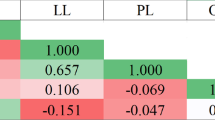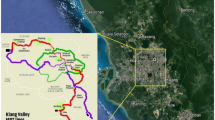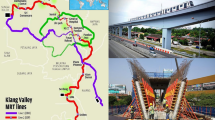Abstract
Circular failure can be seen in weak rocks, the slope of soil, mine dump, and highly jointed rock mass. The challenging issue is to accurately predict the safety factor (SF) and the behavior of slopes. The aim of this study is to offer advanced and accurate models to predict the SF of slopes through machine learning methods improved by optimization algorithms. To this view, three different methods, i.e., trial and error (TE) method, gravitational search algorithm (GSA), and whale optimization algorithm (WOA) were used to investigate the proper control parameters of least squares support vector machine (LSSVM) method. In the constructed LSSVM-TE, LSSVM-GSA and LSSVM-WOA methods, six effective parameters on the SF, such as pore pressure ratio and angle of internal friction, were used as the input parameters. The results of the error criteria indicated that both GSA and WOA can improve the performance prediction of the LSSVM method in predicting the SF. However, the LSSVM-WOA method, with root mean square error of 0.141, performed better than the LSSVM-GSA with root mean square error of 0.170.







Similar content being viewed by others
References
Fattahi H (2017) Risk assessment and prediction of safety factor for circular failure slope using rock engineering systems. Environ Earth Sci 76:224
Duncan JM (1996) Soil slope stability analysis. Landslides, investigation and mitigation, vol 247. Transportation Research Board Special Report, US National Research Council, pp 337–371
Zhang J-F, Ding H (2005) Generalized 3D limit-equilibrium method for slope stability analysis and its application. Chin J Rock Mech Eng 3:1–12
Cheng Y, Lansivaara T, Wei W (2007) Two-dimensional slope stability analysis by limit equilibrium and strength reduction methods. Comput Geotech 34:137–150
Gu T, Wang J, Fu X, Liu Y (2015) GIS and limit equilibrium in the assessment of regional slope stability and mapping of landslide susceptibility. Bull Eng Geol Environ 74:1105–1115
Xu J (2011) Debris slope stability analysis using three-dimensional finite element method based on maximum shear stress theory. Environ Earth Sci 64:2215–2222
Luo N, Bathurst RJ, Javankhoshdel S (2016) Probabilistic stability analysis of simple reinforced slopes by finite element method. Comput Geotech 77:45–55
Li D-Q, Qi X-H, Cao Z-J, Tang X-S, Phoon K-K, Zhou C-B (2016) Evaluating slope stability uncertainty using coupled Markov chain. Comput Geotech 73:72–82
Bhandari T, Hamad F, Moormann C, Sharma KG, Westrich B (2016) Numerical modelling of seismic slope failure using MPM. Comput Geotech 75:126–134
Jiang Q, Qi Z, Wei W, Zhou C (2015) Stability assessment of a high rock slope by strength reduction finite element method. Bull Eng Geol Environ 74:1153–1162
Sun S, Sun H, Wang Y, Wei J, Liu J, Kanungo DP (2014) Effect of the combination characteristics of rock structural plane on the stability of a rock-mass slope. Bull Eng Geol Environ 73:987–995
Martel SJ, Muller JR (2000) A two-dimensional boundary element method for calculating elastic gravitational stresses in slopes. Pure Appl Geophys 157:989–1007
Lim K, Li AJ, Lyamin AV (2015) Three-dimensional slope stability assessment of two-layered undrained clay. Comput Geotech 70:1–17
Li XZ, Xu Q (2016) Application of the SSPC method in the stability assessment of highway rock slopes in the Yunnan province of China. Bull Eng Geol Environ 75:551–562
Tschuchnigg F, Schweiger HF, Sloan SW (2015) Slope stability analysis by means of finite element limit analysis and finite element strength reduction techniques. Part II: back analyses of a case history. Comput Geotech 70:178–189
Kaya A (2016) Geotechnical assessment of a slope stability problem in the Citlakkale residential area (Giresun, NE Turkey). Bull Eng Geol Environ. doi:https://doi.org/10.1007/s10064-016-0896-0
Salmi EF, Hosseinzadeh S (2015) Slope stability assessment using both empirical and numerical methods: a case study. Bull Eng Geol Environ 74:13–25
Bui XN, Muazu MA, Nguyen H (2019) Optimizing Levenberg–Marquardt backpropagation technique in predicting factor of safety of slopes after two-dimensional OptumG2 analysis. Eng Comput. https://doi.org/10.1007/s00366-019-00741-0
Cao MS, Qiao PZ (2008) Neural network committee-based sensitivity analysis strategy for geotechnical engineering problems. Neural Comput Appl 17:509–519
Binh Thai P, Manh Duc N, Kien-Trinh Thi B, Prakash I, Chapi K, Dieu Tien B (2019) A novel artificial intelligence approach based on multi-layer perceptron neural network and biogeography-based optimization for predicting coefficient of consolidation of soil. CATENA 173:302–311
Choobbasti AJ, Farrokhzad F, Barari A (2009) Prediction of slope stability using artificial neural network (case study: Noabad, Mazandaran, Iran). Arab J Geosci 2:311–319
Chen J, Yin J-H, Lee CF (2003) Upper bound limit analysis of slope stability using rigid finite elements and nonlinear programming. Can Geotech J 40:742–752
Kaunda RB, Chase RB, Kehew AE, Kaugars K, Selegean JP (2010) Neural network modeling applications in active slope stability problems. Environ Earth Sci 60:1545–1558
Zhang ZF, Liu ZB, Zheng LF, Zhang Y (2014) Development of an adaptive relevance vector machine approach for slope stability inference. Neural Comput Appl 25:2025–2035
Aghajani HF, Salehzadeh H, Shahnazari H (2015) Application of artificial neural network for calculating anisotropic friction angle of sands and effect on slope stability. J Central South Univ 22:1878–1891
Gordan B, Armaghani DJ, Hajihassani M, Monjezi M (2016) Prediction of seismic slope stability through combination of particle swarm optimization and neural network. Eng Comput 32:85–97
Qi C, Tang X (2018) Slope stability prediction using integrated metaheuristic and machine learning approaches: a comparative study. Comput Ind Eng 118:112–122
Jian Z, Li E, Yang S, Wang M, Shi X, Yao S, Mitri HS (2019) Slope stability prediction for circular mode failure using gradient boosting machine approach based on an updated database of case histories. Saf Sci 118:505–518
Sari PA, Suhatril M, Osman N et al (2020) Developing a hybrid adoptive neuro-fuzzy inference system in predicting safety of factors of slopes subjected to surface eco-protection techniques. Eng Comput 36:1347–1354
Rukhaiyar S, Alam MN, Samadhiya NK (2018) A PSO-ANN hybrid model for predicting factor of safety of slope. Int J Geotech Eng 12(6):556–566
Ghaleini EN, Koopialipoor M, Momenzadeh M et al (2019) A combination of artificial bee colony and neural network for approximating the safety factor of retaining walls. Eng Comput 35:647–658
Koopialipoor M, Jahed Armaghani D, Hedayat A et al (2019) Applying various hybrid intelligent systems to evaluate and predict slope stability under static and dynamic conditions. Soft Comput 23:5913–5929
Sun Y, Li G, Zhang N, Chang Q, Xu J, Zhang J (2020) Development of ensemble learning models to evaluate the strength of coal-grout materials. Int J Min Sci Technol. https://doi.org/10.1016/j.ijmst.2020.09.002
Zhang J, Wang Y, Sun Y, Li G (2020) Strength of ensemble learning in multiclass classification of rockburst intensity. Int J Numer Anal Meth Geomech 44:1833–1853
Zhang J, Sun Y, Li G, Wang Y, Sun J, Li J (2020) Machine-learning-assisted shear strength prediction of reinforced concrete beams with and without stirrups. Eng Comput. https://doi.org/10.1007/s00366-020-01076-x
Zhang J, Wang Y (2020) An ensemble method to improve prediction of earthquake induced soil liquefaction: a multi-dataset study. Neural Comput Appl. https://doi.org/10.1007/s00521-020-05084-2
Sun Y, Li G, Zhang J, Sun J, Xu J (2020) Development of an ensemble intelligent model for assessing the strength of cemented paste backfill. Adv Civil Eng. https://doi.org/10.1155/2020/1643529
Zhang J, Li D, Wang Y (2020) Toward intelligent construction: prediction of mechanical properties of manufactured-sand concrete using tree-based models. J Clean Prod 258:120665
Sun Y, Li G, Zhang J (2020) Developing hybrid machine learning models for estimating the unconfined compressive strength of jet grouting composite: a comparative study. Appl Sci 10(5):1612
Sun Y, Zhang J, Li G, Wang Y, Sun J, Jiang C (2019) Optimized neural network using beetle antennae search for predicting the unconfined compressive strength of jet grouting coalcretes. Int J Numer Anal Meth Geomech 43(4):801–813
Zhou J, Shi X, Li X (2016) Utilizing gradient boosted machine for the prediction of damage to residential structures owing to blasting vibrations of open pit mining. J Vib Control 22(19):3986–3997
Zhou J, Li X, Mitri HS (2015) Comparative performance of six supervised learning methods for the development of models of hard rock pillar stability prediction. Nat Hazards 79:291–316
Armaghani DJ, Asteris PG (2020) A comparative study of ANN and ANFIS models for the prediction of cement-based mortar materials compressive strength. Neural Comput Appl. https://doi.org/10.1007/s00521-020-05244-4
Asteris PG, Douvika MG, Karamani CA, Skentou AD, Chlichlia K, Cavaleri L, Daras T, Armaghani DJ, Zaoutis TE (2020) A novel heuristic algorithm for the modeling and risk assessment of the COVID-19 pandemic phenomenon. Comput Model Eng Sci 125(2):815–828. https://doi.org/10.32604/cmes.2020.013280
Zhou J, Li X, Mitri HS (2016) Classification of rockburst in underground projects: comparison of ten supervised learning methods. J Comput Civil Eng 30(5):04016003
Sun J, Zhang J, Gu Y, Huang Y, Sun Y, Ma G (2019) Prediction of permeability and unconfined compressive strength of pervious concrete using evolved support vector regression. Constr Build Mater 207:440–449
Zhou J, Shi X, Du K, Qiu X, Li X, Mitri HS (2017) Feasibility of random-forest approach for prediction of ground settlements induced by the construction of a shield-driven tunnel. Int J Geomech 17(6):04016129
Huang J, Duan T, Zhang Y, Liu J, Zhang J, Lei Y (2020) Predicting the permeability of pervious concrete based on the beetle antennae search algorithm and random forest model. Adv Civil Eng 2020:8863181
Armaghani DJ, Asteris PG, Askarian B, Hasanipanah M, Tarinejad R (2020) Huynh VV (2020) Examining Hybrid and Single SVM Models with Different Kernels to Predict Rock Brittleness. Sustainability 12:2229
Yang H, Rad HN, Hasanipanah M, Amnieh HB, Nekouie A (2020) Prediction of vibration velocity generated in mine blasting using support vector regression improved by optimization algorithms. Nat Resour Res 29(2):807–830
Yang H, Wang Z, Song K (2020) A new hybrid grey wolf optimizer-feature weighted multiple kernel-support vector regression technique to predict TBM performance. Eng Comput. https://doi.org/10.1007/s00366-020-01217-2
Apostolopoulou M et al (2020) Mapping and holistic design of natural hydraulic lime mortars. Cem Concr Res 136:106167. https://doi.org/10.1016/j.cemconres.2020.106167
Asteris PG et al. (2020) On the metaheuristic models for the prediction of cement metakaolin mortars compressive strength. Metaheuristic Comput Appl 1(1): 63–99. https://doi.org/10.12989/mca.2020.1.1.063
Yang H, Koopialipoor M, Armaghani DJ, Gordan B, Khorami M, Tahir MM (2020) Intelligent design of retaining wall structures under dynamic conditions. Steel Compos Struct 31(6):629–640
Asteris PG, Apostolopoulou M, Skentou AD, Antonia Moropoulou A (2019) Application of artificial neural networks for the prediction of the compressive strength of cementbased mortars. Comput Concr 24(4):329–345
Asteris PG, Armaghani DJ, Hatzigeorgiou Karayannis CG, Pilakoutas K (2019) Predicting the shear strength of reinforced concrete beams using Artificial Neural Networks. Comput Concr 24(5):469–488
Hasanipanah M, Keshtegar B, Thai DK et al (2020) An ANN adaptive dynamical harmony search algorithm to approximate the flyrock resulting from blasting. Eng Comput. https://doi.org/10.1007/s00366-020-01105-9
Sah N, Sheorey P, Upadhyaya L (1994) Maximum likelihood estimation of slope stability. Int J Rock Mech Min Sci 31:47–53
Lin P, Su M, Lin M, Lee T (1990) Investigation on the failure of a building constructed on a hillslope. In: Proceedings of the 2nd international symposium on field measurements in geomechanics, Kobe, 6–9 April 1987 V1. A.A. Balkema, Rotterdam, pp P547–P555. Int J Rock Mech Min Sci Geomech Abstr 2:A114
Madzic E (1988) Stability of unstable final slope in deep open iron mine landslides, vol 1. Balkema, Rotterdam, pp 455–458
Hemmati-Sarapardeh A, Larestani A, Nait Amar M, Hajirezaie S (2020) Applications of artificial intelligence techniques in the petroleum industry. Gulf Professional Publishing. https://doi.org/10.1016/C2018-0-04421-7
Hemmati-Sarapardeh A, Nait Amar M, Soltanian MR et al (2020) Modeling CO2 solubility in water at high pressure and temperature conditions. Energy Fuels 34:4761–4776
Suykens JAK, Vandewalle J (1999) Least squares support vector machine classifiers. Neural Process Lett 9:293–300
Forrester AIJ, Sóbester A, Keane AJ (2008) Engineering Design via Surrogate Modelling: A practical Guide. J. Wiley
Rashedi E, Nezamabadi-Pour H, Saryazdi S (2009) GSA: a gravitational search algorithm. Inf Sci (Ny) 179:2232–2248
Mirjalili S, Lewis A (2016) The Whale Optimization Algorithm. Adv Eng Softw 95:51–67
Hasanipanah M, Armaghani DJ, Amnieh HB, Majid MZA, Tahir MMD (2017) Application of PSO to develop a powerful equation for prediction of flyrock due to blasting. Neural Comput Appl 28(1):1043–1050
Hasanipanah M, Bakhshandeh Amnieh H, Arab H, Zamzam MS (2018) Feasibility of PSO–ANFIS model to estimate rock fragmentation produced by mine blasting. Neural Comput Appl 30(4):1015–1024
Ye J, Dalle J, Nezami R et al (2020) Stochastic fractal search tuned ANFIS model to predict blast-induced air overpressure. Eng Comput. https://doi.org/10.1007/s00366-020-01085-w
Zhang W, Zhang R, Wu C, Goh ATC, Wang L (2020) Assessment of basal heave stability for braced excavations in anisotropic clay using extreme gradient boosting and random forest regression. Underground Space. https://doi.org/10.1016/j.undsp.2020.03.001
Hasanipanah M, Bakhshandeh HA (2020) A fuzzy rule-based approach to address uncertainty in risk assessment and prediction of blast-induced flyrock in a quarry. Nat Resour Res. https://doi.org/10.1007/s11053-020-09616-4
Huang J, Zhang J, Ren J, Chen H (2021) Anti-rutting performance of the damping asphalt mixtures (DAMs) made with a high content of asphalt rubber (AR). Constr Build Mater 271:121878
Chen Z, Li H, Goh ATC, Wu C, Zhang W (2020) Soil liquefaction assessment using soft computing approaches based on capacity energy concept. Geosciences 10(9):330. https://doi.org/10.3390/geosciences10090330
Fattahi H, Hasanipanah M (2021) An integrated approach of ANFIS-grasshopper optimization algorithm to approximate flyrock distance in mine blasting. Eng Comput. https://doi.org/10.1007/s00366-020-01231-4
Zhou J, Nekouie A, Arslan CA, Pham BT, Hasanipanah M (2019) Novel approach for forecasting the blast-induced AOp using a hybrid fuzzy system and firefly algorithm. Eng Comput. https://doi.org/10.1007/s00366-019-00725-0
Zhou J, Li C, Arslan CA, Hasanipanah M, Amnieh HB (2021) Performance evaluation of hybrid FFA-ANFIS and GA-ANFIS models to predict particle size distribution of a muck-pile after blasting. Eng Comput 37:265–274
Zhang W, Zhang R, Wu C, Goh ATC, Lacasse S, Liu Z, Liu H (2020) State-of-the-art review of soft computing applications in underground excavations. Geosci Front 11:1095–1106
Hasanipanah M, Zhang W, Armaghani DJ, Rad HN (2020) The potential application of a new intelligent based approach in predicting the tensile strength of rock. IEEE Access 8:57148–57157
Goh ATC, Zhang RH, Wang W, Wang L, Liu H, Zhang WG (2020) Numerical study of the effects of groundwater drawdown on ground settlement for excavation in residual soils. Acta Geotech 15:1259–1272
Ding X, Hasanipanah M, Rad HN, Zhou W (2020) Predicting the blast-induced vibration velocity using a bagged support vector regression optimized with firefly algorithm. Eng Comput. https://doi.org/10.1007/s00366-020-00937-9
Wang L, Wu C, Tang L, Zhang W, Lacasse S, Liu H, Gao L (2020) Efficient reliability analysis of earth dam slope stability using extreme gradient boosting method. Acta Geotech 15:3135–3150
Nikafshan Rad H, Hasanipanah M, Rezaei M, Eghlim AL (2019) Developing a least squares support vector machine for estimating the blast-induced flyrock. Eng Comput 34(4):709–717
Huang J, Kumar GS, Sun Y (2021) Evaluation of workability and mechanical properties of asphalt binder and mixture modified with waste toner. Constr Build Mater 276:122230
Hasanipanah M, Amnieh HB (2020) Developing a new uncertain rule-based fuzzy approach for evaluating the blast-induced backbreak. Eng Comput. https://doi.org/10.1007/s00366-019-00919-6
Huang J, Asteris PG, ManafiKhajeh Pasha S et al (2020) A new auto-tuning model for predicting the rock fragmentation: a cat swarm optimization algorithm. Eng Comput. https://doi.org/10.1007/s00366-020-01207-4
Hasanipanah M, Meng D, Keshtegar B, Trung NT, Thai DK (2020) Nonlinear models based on enhanced Kriging interpolation for prediction of rock joint shear strength. Neural Comput Appl. https://doi.org/10.1007/s00521-020-05252-4
Author information
Authors and Affiliations
Corresponding author
Rights and permissions
About this article
Cite this article
Zeng, F., Nait Amar, M., Mohammed, A.S. et al. Improving the performance of LSSVM model in predicting the safety factor for circular failure slope through optimization algorithms. Engineering with Computers 38 (Suppl 3), 1755–1766 (2022). https://doi.org/10.1007/s00366-021-01374-y
Received:
Accepted:
Published:
Issue Date:
DOI: https://doi.org/10.1007/s00366-021-01374-y




